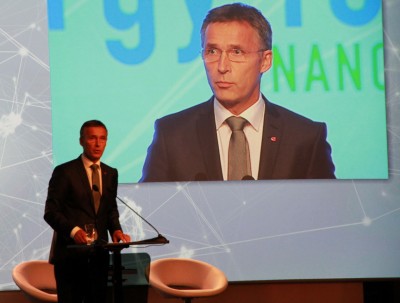NEWS ANALYSIS: Just as Norway experiences some of its warmest winter days ever comes more news of an ongoing political storm over the government’s long-awaited climate report. It’s been delayed several times because of political disagreement within the government coalition, and there’s no guarantee it will finally be released before the summer holidays.

Temperatures weren’t only rising at weather stations around Norway this week. Debate has also been heated as politicians from Norway’s three-party coalition government keep trying to agree on how they can meet the emissions reduction goals set by the Parliament back in 2008.
All the parties represented in parliament (Stortinget), with the exception of the conservative Progress Party, agreed with the government at that time to cut, by 2020, emissions that can damage the climate by 30 percent from the level they were at in the 1990s. The subsequent disagreement, also within the government coalition itself, has been over how to achieve those goals.
The disagreement among the government’s dominant and generally industry-friendly Labour Party and its partners, the Socialist Left (SV) and the Center Party, has been so heated that opposition parties recently suggested they “stop torturing themselves” and drop their efforts to unify over the climate report they’ve intended to present several times but haven’t managed to write. Instead, they can simply try to hash out ways of cutting emissions through parliamentary debate.
“We acknowledge that their work on the climate report is very demanding,” Nikolai Astrup, climate spokesman for the Conservative Party, told newspaper Aftenposten. “So we’re reaching out a hand: Let us arrive on a new, broad compromise in the Storting.”

The biggest argument is over how much of the emissions cuts should be made within Norway, versus how much Norway should pay to finance emissions cuts in other countries. Until now, Norway has been widely viewed as buying its way out of making emissions cuts at home, to protect Norwegian industry and jobs.
Norway’s oil and gas industry, combined with the country’s small population, have long left Norway with among the highest level of emissions on a per capita basis in the world. Emissions of nitrogen oxides (NOx) in 2010 alone, according to state statistics bureau SSB, were 20 percent higher than the level Norway had promised to meet under international agreements. The biggest sources of the NOx emissions in Norway are the shipping and fishing industries, oil and gas operations, road traffic and other industrial operations.
Norway’s total emissions, though, are small compared to countries like China, prompting Labour Party secretary Raymond Johansen to maintain that it’s more effective to help finance much bigger cuts abroad. Neither business and industry nor labour federation LO wants to demand further cuts from Norwegian industry, claiming the means of doing so would be so expensive that they will jeopardize jobs and the very existence of many companies. They argue that Norway’s oil and gas industry already is among the “cleanest” in the world and can’t be expected to take the brunt of tough climate measures.
Finance Minister Sigbjørn Johnsen of the Labour Party seems to agree, along with other top officials within Labour like Johansen. That could leave the government, which is dominated by Labour, promoting more programs to pay for emissions cuts and rain forest preservation abroad.
Newspaper Aftenposten reported on Thursday that another fight is going on within the government, not just over demands for more emissions cuts at home and measures to further reduce road traffic, but also over forestry operations. The government partners can’t agree on whether Norway’s vast forest areas should be preserved or subjected to more chopping, for the sake of the climate. Trees and plants can capture carbon emissions, argue some, while forest owners argue that forest growth is stagnating and more chopping could lead to new growth.
So the debate goes on, and Prime Minister Jens Stoltenberg recently refused to guarantee the climate report would be released in June as now scheduled. Meanwhile, a recent survey indicated that Norwegians’ concern for climate issues has waned in recent years, also among youth. Environmental commitment among young Norwegians has declined, but environmental organizations remain highly vocal. One of them, Bellona, announced plans this week for an ambitious environmental research laboratory called the Sahara Forest Project. Financed with grants from Norwegian fertilizer and chemical company Yara, the idea is to use sand, sun, salt and CO2 to produce electricity, food, fresh water and vegetation. It’s not located anywhere near Norway, though, rather in the desert of Qatar.
Views and News from Norway/Nina Berglund
Please support our stories by clicking on the “Donate” button now:

